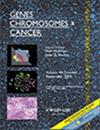T-cell prolymphocytic leukemia (T-PLL) is a rare and aggressive mature T-cell malignancy characterized by marked lymphocytosis, B symptoms, lymphadenopathy, and hepatosplenomegaly. There is no standard treatment approach, and in the absence of an allogeneic transplant, the prognosis remains poor. The disease-defining cytogenetic abnormality in T-PLL is the juxtaposition of the TCL1-family oncogene to the TCR gene enhancer locus primarily due to an inversion of chromosome 14, that is, inv(14). The application of next-generation sequencing technologies led to the discovery of highly recurrent gain-of-function mutations in JAK1/3 and STAT5B in over 70% of T-PLL providing opportunities for therapeutic intervention using small molecule inhibitors. Additional genetic mechanisms that may contribute to the pathogenesis of T-PLL remain unknown. Herein we describe the identification of a novel gene fusion SMCHD1::JAK2 resulting from a translocation between chromosome 9 and 18 involving SMCHD1 exon 45 and JAK2 exon 14 (t(9;18)(p24.1;p11.32)(chr9:g.5080171::chr18:g.2793269)), a previously undescribed genetic event in a patient with T-PLL harboring the key disease defining inv(14) resulting in rearrangement of TCL1 and TRA/D. In this manuscript, we describe the clinical and genetic features of the patient's disease course over a 25-month post-treatment duration using ruxolitinib and duvelisib.


